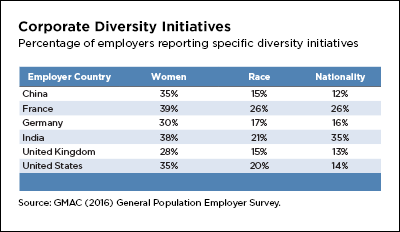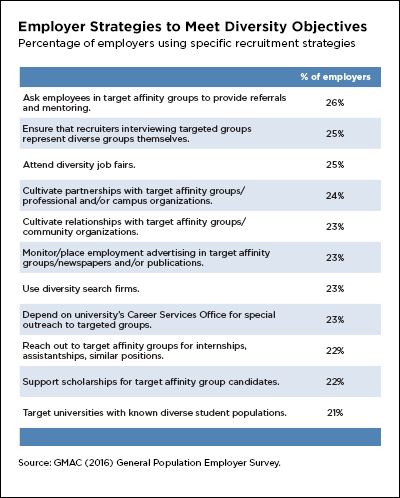- Improve their decision making and perform better financially,
- Have greater access to expanded talent pools that were previously underrepresented,
- Improve their customer orientation and employee satisfaction, and
- Are able to respond more quickly to shifting markets and meet new customer needs.
Achieving greater diversity is no simple task, considering the hurdles companies face. The share of women in corporate leadership roles around the globe is woefully small, despite the fact that they represent nearly half the labor force in most developed economies. In the United States, the growing racial and ethnic diversity of the population, particularly as it relates to African Americans and Hispanic Americans, is not yet reflected in the ranks of senior management in private U.S. industry.
Company Organizational Goals Include Diversifying the Workforce
Findings from two recent GMAC employer surveys show that many companies worldwide are making diversity in hiring part of their annual organizational goals and are investing in diversity initiatives. A total of 842 employers—representing more than 530 companies across 40 countries—responded to GMAC’s 2016 Corporate Recruiters Survey. These respondents are employers who work directly with business schools to recruit MBA and other business graduates. Overall, more than a third of these employers (35%) cited diversifying their workforce as a key company goal. U.S. companies lead the way in this effort, with 40 percent of employers citing diversifying the workforce as an organizational goal, in contrast to 25 percent of companies in Asia-Pacific, 18 percent in Europe, and 16 percent in Latin America.
Diversity Efforts Target Groups by Gender, Race/Ethnicity, and Nationality
GMAC researchers wanted to dive beneath the surface of these high-level goals and learn more about what companies actually are doing to diversify their talent pipelines. So, for the first time they asked employers specifically about their diversity recruitment initiatives—what groups they target for outreach and what strategies they use to meet their diversity recruiting objectives. These questions were posed in a General Population Employer Survey that GMAC conducted to supplement the findings of the Corporate Recruiters Survey with deeper insights into the business and hiring practices of companies in the wider marketplace (i.e., beyond those that routinely recruit from business schools). Nearly 1,300 employers responded to this survey, including employers from six countries—China, France, Germany, India, the United Kingdom, and the United States.
Findings from the General Population Employer Survey (see table below) show that the greatest share of corporate diversity initiatives is geared toward recruiting women, with 34 percent of respondents overall reporting such initiatives. France led the group at 39 percent of respondents, followed by India (38%) and China and the United States, at 35 percent each.

All employers also recruit among racial and ethnic population segments, top among them being employers located in France (26% of respondents), India (21%) and the United States (20%). India and France have the largest share of employers who recruit based on nationality, at 35 percent and 26 percent, respectively. The shares for other employers in the sample were 16 percent or less.
About a quarter or more of respondents engage in diversity recruitment initiatives that put them in direct personal contact with the targeted candidates they wish to recruit, and they engage their employees directly in many of these activities—such as asking employees in targeted groups to provide referrals and mentoring (26% of respondents), ensuring recruiters who interview candidates represent diverse groups themselves (25%), and cultivating relationships with professional and community organizations (24% and 23%, respectively). The second table below shows that nearly a quarter of respondents overall also engage with university Career Services Offices for special outreach (23%) and target universities with known diverse student populations (21%).
Employers Engage in Diversity Initiatives That Work
Comparing the results of GMAC’s General Population Employer Survey with findings from a recent Harvard Business Review study of three decades’ worth of diversity data from more than 800 U.S. firms reveals that the GMAC study respondents engage in diversity initiatives that have been shown to be most effective. According to the HBR study, diversity initiatives that include targeted college recruitment programs and mentoring programs are among the most effective company strategies for boosting the share of women and minority candidates in a company’s management ranks. For example, the HBR study reports that five years after a company implements a college recruitment program targeting female employees, the share of white women, African American women, Hispanic American women, and Asian American women in its management rises by 10 percent. Mentoring programs also contribute to increased diversity in upper management: On average, they increase the representation of African American, Hispanic American, and Asian American women and Hispanic American and Asian American men by 9 percent to 24 percent.

Lessons for Business Schools
GMAC’s General Population Employer Study findings should resonate with business schools determined to expand their appeal to women and underrepresented ethnic and racial populations. The same strategies that companies employ to diversify their workforce and management ranks serve as a powerful complement to engagement activities that schools should have on their radar:
- Deliberately seeking out companies that have known diversity recruitment programs and inviting them to their campuses,
- Adopting (or expanding) the use of mentoring programs for women and racial and ethnic minority groups on campus, and
- Partnering these students with like-minded companies, which could help boost their employment and advancement opportunities.
A new white paper from GMAC, Increasing Graduate Management Education Candidate Diversity: Improving Attraction to Underrepresented Segments, contains detailed analysis on the subject of minority recruitment for business schools, and recommends strategies similar to those emanating from the GMAC employer study. This white paper can be found at gmac.com/researchreports.